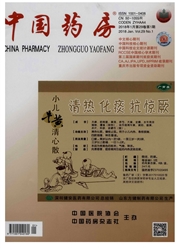

 中文摘要:
中文摘要:
目的:比较金针酸枣袋泡剂与其煎剂的质量控制指标,探讨该袋泡剂对煎剂的补充替代性。方法:分别采用热浸法和水煎法制备金针酸枣袋泡剂和煎剂供试品溶液,测定并比较2种制剂中水溶性浸出物和总黄酮的含量;另考察袋泡剂浸泡不同时间(0、5、10、15、20、25、30 min)的浸出率以优化浸泡时间。结果:袋泡剂与煎剂中水溶性浸出物平均含量分别为50.56%、44.45%(P〈0.05),总黄酮含量分别为0.64、0.69 mg/g(P〈0.05)。袋泡剂在前20 min溶出量不断增加、浸出率升高,25 min后逐渐达到平衡状态。结论:综合考虑袋泡剂的便捷性及各指标的考察结果,认为2种制剂在主要的质量控制指标上差异不大,袋泡剂可作为煎剂的补充。
 英文摘要:
英文摘要:
OBJECTIVE: To compare the quality control index between Jinzhen Suanzao teabag and decoction, and explore the alternative supplement of teabag to decoction. METHODS: The test sample solutions of Jinzhen Suanzao teabag and decoction were prepared by hot-maceration method and water-decoction method. The contents of water soluble extract and total flavonoids were de- termined and compared between 2 kinds of preparation. The leaching rates of teabag were investigated at different soak time (0, 5, 10, 15, 20, 25, 30 min) to optimize soaking time. RESULTS: The average content of water soluble extract were 50.56% and 44.45% (P〈0.05) respectively for the teabag and decoction. The total flavonoids content were 0.64 mg/g and 0.69 mg/g (P〈 0.05). The dissolution amount of teabag were increasing and leaching rate increased within first 20 min, and reached balance gradu- ally 25 min later. CONCLUSIONS: According to the convenience of use and results of each index, the difference in quality control index is not great between 2 kinds of preparation. Teabag can be as the supplement of decoction.
 同期刊论文项目
同期刊论文项目
 同项目期刊论文
同项目期刊论文
 期刊信息
期刊信息
